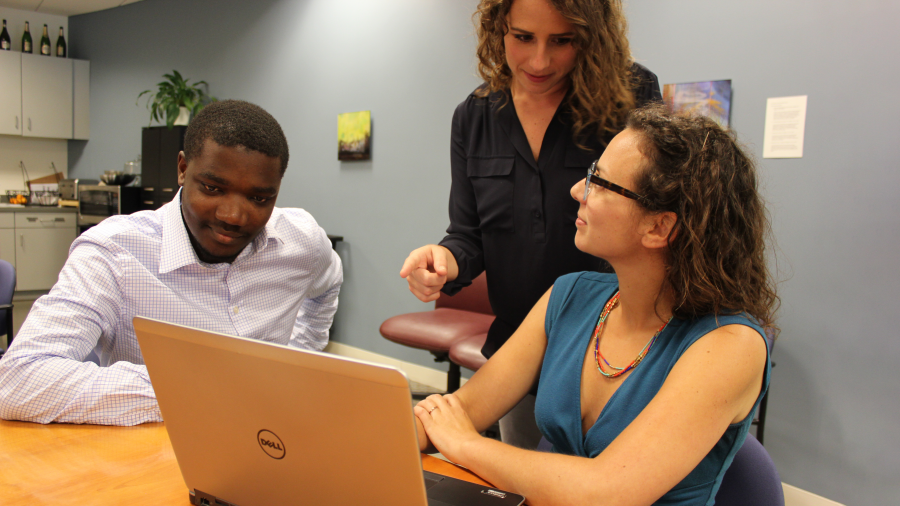
SESYNC Videos
- The Toolbox Initiative: An Approach to Facilitating Discussion Among Interdisciplinary Teams
- Synthesis Research and Team Science Process to Address Socio-Environmental Problems
The Science of Team Science Video Series
- The Science of Team Science Part 1: Why Team Science?
- The Science of Team Science Part 2: Conducting Team Science and Measuring Outcomes
- The Science of Team Science Part 3: Understanding Teams
Knowledge Integration Across Disciplines Video Series
- Knowledge Integration Across Disciplines Part 1: Introduction to Collaboration Across Disciplines
- Knowledge Integration Across Disciplines Part 2: Vocabulary
- Knowledge Integration Across Disciplines Part 3: Mental Models
- Knowledge Integration Across Disciplines Part 4: Knowledge Integration Strategies
SESYNC Resources
- Practices for facilitating interdisciplinary synthetic research: The National Socio-Environmental Synthesis Center (SESYNC)
- Building an Interdisciplinary Team
- Facilitating Interdisciplinary Meetings: A Practical Guide
- First Meeting Guide
- What Is Interdisciplinary Team Research? Are There Best Practices?
- Who Are Stakeholders? What Is the Role of Stakeholders in Convergent Research?
- What Is a Shared Mental Model? Why Are Mental Models Useful for Interdisciplinary Research?
- Measuring Societal Impact for Convergent Research
- Best Practices for Interdisciplinary Team Research: Shaping a Team’s Social Environment
- Creating Interdisciplinary Research Teams, A Two Session Exercise
- SESYNC Immersion Postdoctoral Program
Other Resources
- Collaboration and Team Science Field Guide
- Enhancing the Effectiveness of Team Science
- Best Practices for Teaching S-E Synthesis with Case Studies: Using Stakeholder Analysis in the Classroom
- University of California, Irvine, Team Scholarship Acceleration Lab
- Integration and Implementation Insights Blog
Recommended Publications
Many of the publications on interdisciplinarity and team science are descriptive case studies, theoretical papers, or fundamental research papers based on the study of teams or are focused on health care team science; however, the articles listed below are ones that provide some practical application information.
- Bammer, G. (2022, June 16). Understanding diversity primer: 9. Team Roles. Integration and Implementation Insights. https://i2insights.org/2022/06/16/diversity-in-team-roles/
- Cvitanovic, C., Colvin, R.M., Reynolds, K.J., & Platow, M. (2020). Applying an organizational psychology model for developing shared goals in interdisciplinary research teams. One Earth, 2(1), 75-83. https://doi.org/10.1016/j.oneear.2019.12.010
- Cvitanovic, C., Shellock, R.J., Mackay, M. et al. (2021). Strategies for building and managing ‘trust’ to enable knowledge exchange at the interface of environmental science and policy. Environmental Science & Policy, 123, 179-189. https://doi.org/10.1016/j.envsci.2021.05.020
- Cwik, B., Gonnerman, C., O’Rourke, M. et al. (2022). Building community capacity with philosophy: Toolbox dialogue and climate resilience. Ecology & Society, 27(2). https://ecologyandsociety.org/vol27/iss2/art21/
- Hall, K.L., Vogel, A.L., & Crowston, K. (2019). Comprehensive Collaboration Plans: Practical Considerations Spanning Across Individual Collaborators to Institutional Supports. In: K.L. Hall, A.L. Vogel, & R.T. Croyle (Eds.), Strategies for Team Science Success (pp. 587-612). Springer Nature. https://doi.org/10.1007/978-3-030-20992-6_45
- Hensen, V.R., Cobourn, K.M., Weathers, K.C. et al. (2020). A Practical Guide for Managing Interdisciplinary Teams: Lessons Learned from Coupled Natural and Human Systems Research. Social Sciences, 9(7), 119. https://doi.org/10.3390/socsci9070119
-
Hoffmann, S., Weber, C., & Mitchell, C. (2022). Principles for Leading, Learning, and Synthesizing in Inter- and Transdisciplinary Research. Bioscience, 72(10), 963-977. https://doi.org/10.1093/biosci/biac057
-
LaPensee, E., Doshi, A., & Salem, B. et al. (2021). Mobilizing cross-disciplinary teams to advance translational research using design thinking methods. Journal of Clinical and Translational Science, 5(1), E184. https://doi.org/10.1017/cts.2021.823
-
McInerny, G.J. (2016) Ten Simple Rules for Curating and Facilitating Small Workshops. PLOS Computational Biology, 12(7): e1004745. https://doi.org/10.1371/journal.pcbi.1004745
-
Morgan, S.E., Ahn, S., Mosser, A. et al. (2021). The Effect of Team Communication Behaviors and Processes on Interdisciplinary Teams’ Research Productivity and Team Satisfaction. Informing Science: The International Journal of an Emerging Transdiscipline, 24, 83-110. https://doi.org/10.28945/4857
-
Morss, R.E., Lazrus, H., & Demuth, J.L. (2021). The “inter” within interdisciplinary research: Strategies for building integration across fields. Risk Analysis, 41(7), 1152-1161. https://doi.org/10.1111/risa.13246
-
Norris, P.E., O’Rourke, M., Mayer, A.S. et al. (2016). Managing the wicked problem of transdisciplinary team formation in socio-ecological systems. Landscape and Urban Planning, 154, 115-122. https://doi.org/10.1016/j.landurbplan.2016.01.008
-
Pavelin, K., Pundir, S., & Cham, J.A. (2014). Ten Simple Rules for Running Interactive Workshops. PLOS Computational Biology, 10(2): e1003485. https://doi.org/10.1371/journal.pcbi.1003485